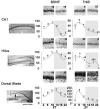Circadian modulation of memory and plasticity gene products in a diurnal species
- PMID: 25063362
- PMCID: PMC4157103
- DOI: 10.1016/j.brainres.2014.07.020
Circadian modulation of memory and plasticity gene products in a diurnal species
Abstract
Cognition is modulated by circadian rhythms, in both nocturnal and diurnal species. Rhythms of clock gene expression occur in brain regions that are outside the master circadian oscillator of the suprachiasmatic nucleus and that control cognitive functions, perhaps by regulating the expression neural-plasticity genes such as brain derived neurotrophic factor (BDNF) and its high affinity receptor, tyrosine kinase B (TrkB). In the diurnal grass rat (Arvicanthis niloticus), the hippocampus shows rhythms of clock genes that are 180° out of phase with those of nocturnal rodents. Here, we examined the hypothesis that this reversal extends to the optimal phase for learning a hippocampal-dependent task and to the phase of hippocampal rhythms in BDNF/TrkB expression. We used the Morris water maze (MWM) to test for time of day differences in reference memory and monitored daily patterns of hippocampal BDNF/TrkB expression in grass rats. Grass rats showed superior long-term retention of the MWM, when the training and testing occurred during the day as compared to the night, at a time when nocturnal laboratory rats show superior retention; acquisition of the MWM was not affected by time of day. BDNF/TrkB expression was rhythmic in the hippocampus of grass rats, and the phase of the rhythms was reversed compared to that of nocturnal rodents. Our findings provide correlational evidence for the claim that the circadian regulation of cognition may involve rhythms of BDNF/TrkB expression in the hippocampus and that their phase may contribute to species differences in the optimal phase for learning.
Keywords: BDNF/TrkB; Circadian rhythm; Cognition; Hippocampus; Morris water maze; Plasticity genes.
Copyright © 2014 Elsevier B.V. All rights reserved.
Figures




References
-
- Amir S, Harbour VL, Robinson B. Pinealectomy does not affect diurnal PER2 expression in the rat limbic forebrain. Neurosci Lett. 2006;399:147–50. - PubMed
-
- Amir S, Robinson B. Thyroidectomy alters the daily pattern of expression of the clock protein, PER2, in the oval nucleus of the bed nucleus of the stria terminalis and central nucleus of the amygdala in rats. Neurosci Lett. 2006;407:254–7. - PubMed
Publication types
MeSH terms
Substances
Grants and funding
LinkOut - more resources
Full Text Sources
Other Literature Sources

